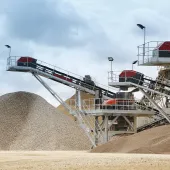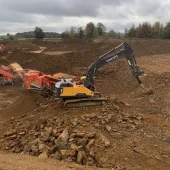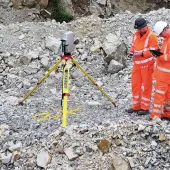MPA worried about future aggregate supplies

Association says second Annual Mineral Planning Survey (AMPS) confirms worrying signals
THE Mineral Products Association (MPA) is calling on government to increase its efforts to overcome inertia in the planning system, in order to ensure a steady and adequate supply of aggregates.
This follows publication of the MPA’s 2nd Annual Mineral Planning Survey (AMPS) for 2012, which highlights that the plan-led system is failing to provide local plans which identify where land for future extraction is located, increasing the risk that adequate reserves of materials might not be available when needed to support economic recovery.
The MPA says the aggregates industry needs the certainty of a fully functioning and ‘fit for purpose’ plan-led system if its capacity to meet the future demand for construction materials is to be maintained.
According to the Association, permitted reserves of sand and gravel are in serious decline and planning authorities are putting too much effort into reducing potential future supply rather than getting on with the business of adopting robust mineral plans. It says most authorities are giving little indication to operators where planning applications are likely to be successful.
Key facts from the Annual Mineral Planning Survey include:
- Average replenishment rates of aggregate reserves (ie the rates at which production is being replaced with new permissions) are continuing to decline. Only 43% of sand and gravel reserves have been replenished in the last 10 years to 2012 and around 98% of hard rock reserves, although these tend to be concentrated in a few major sites and are not evenly distributed.
- There has been a 38% drop in the total tonnage of landbanks in England and Wales since 1997.
- 25% of sand and gravel landbanks in England are below the minimum of seven years and 50% are below 10 years.
- The 15-year average approval rate for hard rock applications is 93% and for sand and gravel applications is 85%.
- The success rate of sand and gravel appeals is 78% over a 15-year period.
- There has been a significant increase in the time it takes to obtain planning permission for sand and gravel since 1996.
- Sand and gravel approvals took an average of 41 months in 2012 and hard rock approvals 38 months; this takes no account of time spent in developing local plans or securing sites and evaluating them prior to plan submission.
- The statistics indicate that pre-application discussions do nothing to shorten this process. The majority of applications still take in excess of 12 months.
- In 2012, only 10 planning applications for new extraction were submitted by members, compared with 40 in 1996.
- At the end of October 2013, only 51 out of 100 mineral planning authorities in England had an adopted Core Strategy, when the original target for completion of these documents was the end of 2007. In Wales, only 11 out of 25 authorities had an adopted Local Development Plan.
The Association says the situation with land-won sand and gravel reserves is continuing to worsen and cause concern. Even against a production rate that is some 40% lower than 2010, sand and gravel reserves are being used up more than twice as fast as new reserves are being permitted. The AMPS data shows that the running average replenishment rate took another tumble from 49% to 45% between 2010 and 2012.
The number of planning applications submitted for aggregate extraction is also low, particularly for sand and gravel. Despite that, permission was only granted for 75% of the tonnage applied for, which is some 10% below the 10-year average.
The MPA says the fact the it is getting more difficult to obtain planning permission for sand and gravel working is worrying, especially with the majority of producing areas, particularly those in the South East, bumping along close to or below the minimum seven-year landbank level.
The lack of a lead from planning authorities is having a less marked effect on crushed rock operations but that is simply because of the slightly better landbank situation. The MPA says serious supply problems are likely to emerge if the planning system is not restored to functionality during the forthcoming year as permitted reserves are not evenly distributed.
According to Nigel Jackson, chief executive of the MPA, the 2nd Annual Mineral Planning Survey bears out the Association’s concerns that it is getting more and more difficult for mineral operators to work with the planning and regulatory system to obtain their ‘licence to operate’.
‘It’s not surprising that the planning applications aren’t coming forward,’ he said. ‘Whilst the overall approval rate of applications is adequate, they take too long, they cost too much – typically between £100,000 and £800,000 – and lengthy pre-application discussions don’t help.’
According the MPA, around 80% of sand and gravel appeals are successful, which means that too many bad decisions are being made on sand and gravel applications. Moreover, the costs of planning appeals are high, which is just money wasted for both quarry companies and planning authorities.
Exacerbating the problem, most mineral plans are out of date. At the end of August 2012, only around 50% of mineral planning authorities in England had an adopted Core Strategy (the most important local planning policy document) and only about 25% of authorities in England and Wales had a Local Development Plan in place.
‘The performance of the plan-led system has been extremely disappointing in spite of recent changes,’ said Mr Jackson. ‘Costs are rising as charges are levied for services that were previously considered part of statutory duties, and the costs of new and often pointless additional regulation are being heaped on top of that. There is a continual drift towards increased planning fees and charges for discussions with no commensurate improvement in planning performance.
‘Operators still feel that the system is now about finding reasons to refuse. The National Planning Policy Framework (NPPF) was supposed to change all that but the early signs are not encouraging. Quick bad decisions may make planning authority performance look good, but do nothing for the economy.
‘Our second survey shows that one year on the situation is not improving. With too few plans, low landbanks, diminishing replenishment rates, increasing costs, and planning inertia fuelling uncertainty, we are storing up supply problems for the recovery. Lack of demand over the last five years is masking underlying supply problems for the future,’ said Mr Jackson.
He added: ‘Government needs to get a grip on the realities rather than assuming things will improve. The Department for Communities and Local Government and the Planning Inspectorate need to step up their monitoring and put pressure on local authorities to ensure that the plan-making system is more streamlined and responsive. There will be significant future aggregates demands as economic recovery continues and major infrastructure projects commence.
‘We can deliver sufficient supplies of aggregates and related products but we need the industry and planning and regulatory systems to be pulling in the same direction to ensure that this sustainable long-term UK supply of mineral products is actually achieved.’
The MPA says it hopes that reporting AMPS information regularly will prompt constructive debate on the realities of aggregates supply, which is essential to the construction industry and the economy.









